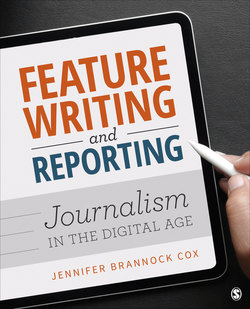Читать книгу Feature Writing and Reporting - Jennifer Brannock Cox - Страница 65
На сайте Литреса книга снята с продажи.
Alternative Storytelling Forms
ОглавлениеReaders do not always have the time or the inclination to read a full feature story. Journalists can still convey interesting and useful information using alternative story forms—short, descriptive features that stand alone to tell a story without the accompaniment of a traditional written article.10 They provide readers an intriguing break from monotonous articles, and they can sometimes better help readers understand a complicated issue by making it more visual or interactive.
The most common alternative story forms in print and online publications tend to be stand-alone photos or photo galleries and graphics. The investigative news site ProPublica created an interactive feature mapping the route of a private garbage truck driver through the streets of New York City. The graphic consists of a map of the city’s largest neighborhoods. When the reader clicks the play button, the map springs to life, clocking the time elapsed and miles traveled, with captions marking each of the truck driver’s stops as they are charted across the map. The interactivity of the map allows readers to truly understand the long distances and dangerous conditions drivers face as they traverse the city. Throughout the journey, pop-up captions detail the struggles drivers face, offer quotes from the drivers and provide impactful numbers demonstrating their work efforts.11
ProPublica’s interactive graphic demonstrating garbage truck routes through the streets of New York City.
ProPublica, “One Night on a Private Garbage Truck in New York City,” by Al Shaw and Kiera Feldman.
Alternative story forms are limited only by journalists’ imaginations. Other common examples include:
Breakout boxes: These are short boxes containing tidbits of information that may be helpful to the reader. Examples include a glossary to help readers understand new terms or jargon related to a topic; follow-up boxes detailing what is known, what is new and what is next; takeaways providing bulleted highlights from a meeting or event; and boxes using numbers to provide information,12 as in this example shown in Figure 2.8.
Figure 2.8 A sample breakout box that could run alongside a traditional news story on the same topic.
Source: http://www.seaturtle.org/
Q & A: Question and Answer features provide a transcript of an interview with a source, showing your questions and your source’s direct answers.
FAQ: Frequently Asked Questions features list quick answers to popular questions readers might have on a subject. For example, in preparation for a state fair, readers may ask about the cost, dates, what rides are included, what performers are playing and so forth.
Reader polls: These may include a short introductory graf educating readers on an issue before asking them to engage by voting with their opinion and/or leaving comments.
Charts: Charts provide a simple visual reference to help readers process data and numbers quickly. In one example from The News & Advance in Lynchburg, Virginia, reporter Shawn Garrett shows how lottery sales in the area compare with others in the state. The arrangement of the rankings within the map, separated by counties, provides a powerful illustration the audience can quickly understand. Readers can also easily see the dramatic disparity between Lynchburg proper and its surrounding counties.13
Games: Some news organizations urge readers to process information using games, such as news quizzes. StudentNewsDaily.com is a nonprofit current events website for high school students. One of the online publication’s features is a weekly news quiz, testing students on their retention of information from the week’s events.
This chart from The News & Advance in Lynchburg, Virginia, is a visually appealing representation of the distribution of lottery sales in the area compared with others across the state.
The News & Advance, “Playing the Lottery in Central Virginia,” by Shawn Garrett.
We will cover more alternative story forms using mobile apps in Chapter 11.
